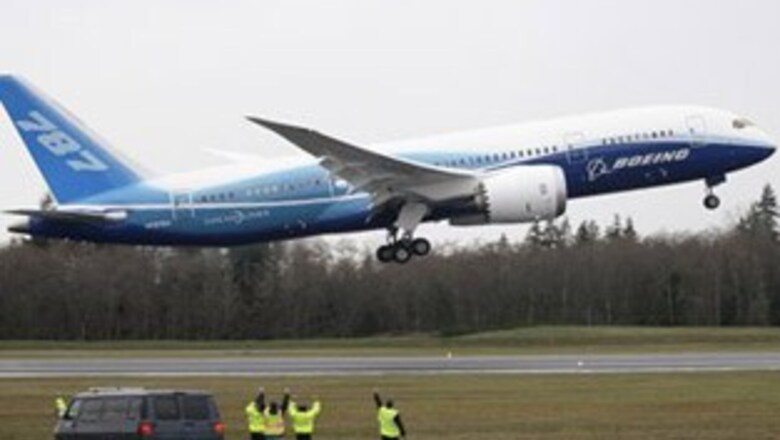
views
Everett, Washington: Boeing's new 787 jetliner finally got airborne on Tuesday, the long-delayed inaugural flight of the world's first commercial plane constructed with half its components made from lightweight composite materials.
The sleek jet lifted off from Everett's Paine Field on a flight over Washington state, beginning an extensive testing program needed to obtain Federal Aviation Administration certification.
"It's very historical. I can't think of a thing about it that I'm not impressed with," said Joe Bierce, a flight instructor for Delta Connection in Jacksonville, Florida, who was among the 25,000 people who gathered to watch the takeoff.
The two-member crew performed a variety of basic system checks before landing at Seattle's Boeing Field about three hours later. Deteriorating weather brought the plane back to earth about an hour earlier than planned, but company spokeswoman Lori Gunter said the pilots managed to test the landing gear and flaps.
Before takeoff, the aircraft paused for several minutes at the end of the runway while warming up its engines, adding to the tension for Boeing employees, customers and airline executives standing on the tarmac.
Although the runway was lined with fire trucks and other emergency vehicles, the first flight looked like a normal takeoff as the huge aircraft kicked up clouds of mist.
The plane is the first of six 787s Boeing will use in the nine-month flight-test program that will subject the planes to conditions well beyond those found in normal airline service.
Chicago-based Boeing, which has orders for 840 of the jets, plans to make the first delivery to Japan's All Nippon Airways late next year.
The 787 is a radical departure in aircraft design. Where other passenger jets are made mostly from aluminum and titanium, about half of the 787 is made of lightweight composite materials such as carbon fiber.
Those materials have long been used on individual parts such as rudders, and on military planes, but the 787 is the most ambitious use of the technology aboard a passenger plane.
Boeing says the aircraft will be quieter, produce lower emissions and use 20 percent less fuel than comparable planes, while giving passengers a more comfortable cabin with better air quality and larger windows.
PAGE_BREAK
Officials cut the flight a little short after rain reduced visibility at Boeing Field.
Boeing spokeswoman Lori Gunter said the flight went well, with the crew able to test the landing gear, flaps and other equipment.
Boeing has relied on suppliers to build huge sections of the plane that are later assembled in Everett. But that approach so far has proved problematic, with ill-fitting parts and other glitches hampering production.
The first flight was supposed to be in 2007, with deliveries the following year. Boeing was forced to push that back five times — delays that have cost the company credibility, sales and billions of dollars.
Most recently, Boeing needed to reinforce the area where the wings join the fuselage. Tests were completed on that fix just two weeks ago.
An eight-week strike last year by Seattle-area production workers also caused problems and factored in Boeing's decision in October to create a second 787 assembly line in North Charleston, S.C.
The 787 remains Boeing's best-selling new plane to date, though some airlines have been forced to cancel or postpone purchase plans because of the weak global economy.
The version being tested will be able to fly up to 250 passengers about 9,000 miles. A stretch version will be capable of carrying 290 passengers and a short-range model up to 330.

















Comments
0 comment